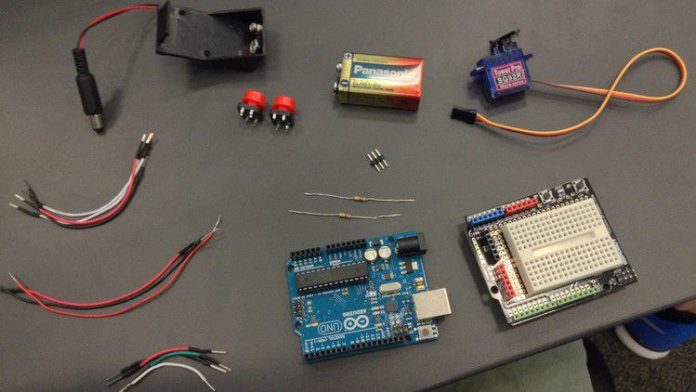Learn by Practicing real world Projects to apply everything you have learned
Description
>>> Learning by theory and Simulation is only half the answer, but connecting, wiring and burning a code to an actual Arduino, not a simulated one is the other more important half, and this is what we will cover in this course, you will learn by making Arduino Practical Projects. <<<
>>> Continues Updates <<<
More Than 55k STUDENT on All of our Courses!!! THANK YOU!!!
Welcome to this course.
Learning By doing is what makes the difference between someone who learn and someone who applies what he learned
In this course you will get the chance to see Arduino in Action, starting from simulation and moving forward to connecting the hardware and testing the code in real life.
This will help you make sure your circuit works as expected and you can witness yourself building your first Arduino fully functional.
The most important thing to note here is that when a circuit work with you in simulation, that doesn’t mean that it will work in real life, in more than 85% of the cases the simulated circuit doesn’t work when you connect it.
What is the best way to Learn, you ask?
Learning by doing Arduino Practical Projects is the learn by practice approach that I prefer
This approach allows you to not only master new Arduino skills but also gain practical knowledge along the way.
Only a few people are satisfied with simulation, but if you want good results you must move on and hook up your circuit and test it out using real-life hardware parts.
I’m trying to help you gain real world practical experience in Arduino, so let’s start.
Arduino Motion Detector: Step By Step Guide
Make your own Arduino Motion Detector and start Catching Intruders, Control devices and lots more Cool Application
>>> This Course will show you how to build an Arduino Motion Detector Device that will Fire an Alarm once an Intruder is detected in a range of 6 to 7 meters, it will take you in a step by step manner to know what each component inside the device circuit is, and what it does and how to wire it up <<<
>>> Continues Updates <<<
4 Star | 1500 STUDENTS!!! THANK YOU!!!
What students are saying:
Bobbie Smith says, “This course gives you excellent information and clear instructions on creating a motion detector. Thank you.”
Welcome to this course.
You will know what is the actual working principle of Motion detectors that you see in banks and in door opining and closing mechanisms and what you can do with it and how to interface it with your own Arduino and make it execute and action using simple codes freely, you will no longer needs to buy a motion detector or customize it since you can make the device yourself.
After this course you will be able to make your own Motion detector and the choice is yours to use it in any application that comes in your mind and can make your life easier, since all connections are explained in details.
Goal From This Course:
– Connect a Motion Detector Sensor to Arduino Board with all necessary Components and make it work.
Required Materials
Hardware:
Arduino or an Arduino clone board (freeduino), or you can make your own custom Arduino board.
PIR Motion Sensor.
A piezo buzzer or an 8-ohm speaker.
9V Battery and connector.
Connecting wires.
Software:
Arduino IDE
Arduino Radar: Step By Step Guide
Create your Own Radar using Arduino and get a Green Map Showing Objects at your own Screen in no time
>>> This course will take you in a step by step guide on how to make your own Radar using Arduino Board. <<<
>>> Continues Updates <<<
4 Star | More Than 3000 STUDENTS!!! THANK YOU!!!
What students are saying:
Nathan Johnnie says, “As always Excellent! ”
Donald R. Lyons, Sr. says, “The course is concise and to the point. There is not a lot of wasted discussion.”
Welcome to this course.
You will get to know how to wire each of these elements, how it works, and why we are using it inside this Project, in no time you will find yourself making your own Radar that shows different object and the distance between you and each object.
A Radar station is a device that collects data related to objects in the surronding environment using Ultrasonic sensors and a Servo motor to cover wider area.
The aim is to make a portable Radar Device
Features it should have
Distance
Angle
Map that show different objects
You will wire sensors and motor to Arduino UNO board and start testing the code yourself, every piece of code is well explained so that you can easily know what each segment does.
A lot of information is waiting for you inside this course, join now and start making your own.
Arduino Web Control: Step By Step Guide
Make your own Arduino Web Control and start Controlling any device that you imagine using A Simple Webpage and Arduino
>>> This Course will teach you how to use a Web Page to Control anything using Arduino, This Guide will take you in a step by step manner to know what each component inside this circuit is, and what it does and how to wire it up, starting with the Ethernet shield and ending with resistors. <<<
>>> Continues Updates <<<
More than 5000 STUDENTS!!! THANK YOU!!!
What students are saying:
Bobbie Smith says, “The instructor is thorough and concise. Thank you.”
Susi Kumar Prava says, “Great, Thank you”
Kalid Al-ahmadi says, “I love It very nice”
Welcome to this course.
You will know what is the actual working principle of Ethernet shield and how to interface and configure it correctly so that you can access your Arduino Powered device from anywhere with an internet connection, and control any device with simple clicks in a webpage.
After this course, you will be able to make your own web controlled device and the choice is yours to use it in any application that comes in your mind and can make your life easier since all connections are explained in details.
We are going to control LEDs from a web page using an Arduino Ethernet module. The Ethernet module will create a server using the router and we will set a web page for this server.
We will use the HTML commands to print the data and to make the buttons on the web page.
When the button on the web page is pressed, we will get some data on the serial monitor. We will save this data in the string and will use this data to turn the LED’s ON or OFF.
Goal From Arduino Web Control Course:
– Connect Arduino Ethernet Shield to Arduino Board with all necessary Components and make it Internet Based.
What you will learn in this Course
– How to Connect an Ethernet Module to Arduino.
– The Right way to Detect Online Actions Using Arduino.
– The Working principle of Internet Control.
– How to interface different type of electronic elements with Arduino.
– How Arduino Can make your life easier.
– Program, burn a code and wire Arduino and Ethernet Module.
– Choose the right tools to start making amazing projects
– Why using Online control with Arduino is better than traditional Control Methods.
[maxbutton id=”1″ url=”https://www.udemy.com/course/facebook-ads-2021-for-beginners/?couponCode=FREEAUGUST” ]























![[100% Free]Python Bootcamp 2020 Build 15 working Applications and Games (31.5 Hours)](https://oyoads.in/wp-content/uploads/2020/05/Python-Bootcamp-2020-Build-15-working-Applications-and-Games-1-100x70.jpg)

![[100% Free]Java Programming: Complete Beginner to Advanced](https://oyoads.in/wp-content/uploads/2020/05/IMG_20200519_054150_522-100x70.jpg)
